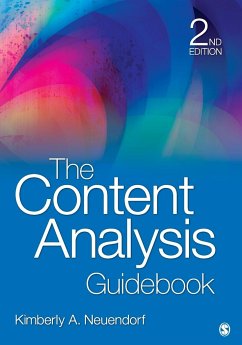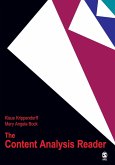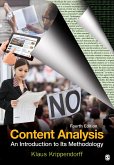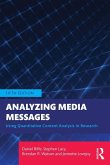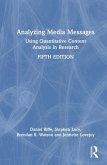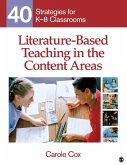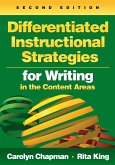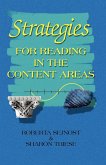Kimberly A. Neuendorf
The Content Analysis Guidebook
Kimberly A. Neuendorf
The Content Analysis Guidebook
- Broschiertes Buch
- Merkliste
- Auf die Merkliste
- Bewerten Bewerten
- Teilen
- Produkt teilen
- Produkterinnerung
- Produkterinnerung
A new edition of this popular student guide to content analysis. Widely adopted on research methods courses across the social sciences.
Andere Kunden interessierten sich auch für
![The Content Analysis Reader The Content Analysis Reader]() Klaus KrippendorffThe Content Analysis Reader137,99 €
Klaus KrippendorffThe Content Analysis Reader137,99 €![Content Analysis Content Analysis]() Klaus KrippendorffContent Analysis201,99 €
Klaus KrippendorffContent Analysis201,99 €![Analyzing Media Messages Analyzing Media Messages]() Daniel RiffeAnalyzing Media Messages46,99 €
Daniel RiffeAnalyzing Media Messages46,99 €![Analyzing Media Messages Analyzing Media Messages]() Daniel RiffeAnalyzing Media Messages152,99 €
Daniel RiffeAnalyzing Media Messages152,99 €![Literature-Based Teaching in the Content Areas Literature-Based Teaching in the Content Areas]() Carole A. CoxLiterature-Based Teaching in the Content Areas73,99 €
Carole A. CoxLiterature-Based Teaching in the Content Areas73,99 €![Differentiated Instructional Strategies for Writing in the Content Areas Differentiated Instructional Strategies for Writing in the Content Areas]() Carolyn ChapmanDifferentiated Instructional Strategies for Writing in the Content Areas39,99 €
Carolyn ChapmanDifferentiated Instructional Strategies for Writing in the Content Areas39,99 €![Strategies for Reading in the Content Areas Strategies for Reading in the Content Areas]() Roberta L. SejnostStrategies for Reading in the Content Areas12,99 €
Roberta L. SejnostStrategies for Reading in the Content Areas12,99 €-
-
-
A new edition of this popular student guide to content analysis. Widely adopted on research methods courses across the social sciences.
Hinweis: Dieser Artikel kann nur an eine deutsche Lieferadresse ausgeliefert werden.
Hinweis: Dieser Artikel kann nur an eine deutsche Lieferadresse ausgeliefert werden.
Produktdetails
- Produktdetails
- Verlag: SAGE Publications Inc
- 2 Revised edition
- Seitenzahl: 458
- Erscheinungstermin: 16. Mai 2016
- Englisch
- Abmessung: 254mm x 178mm x 25mm
- Gewicht: 856g
- ISBN-13: 9781412979474
- ISBN-10: 1412979471
- Artikelnr.: 36380457
- Herstellerkennzeichnung
- Libri GmbH
- Europaallee 1
- 36244 Bad Hersfeld
- gpsr@libri.de
- Verlag: SAGE Publications Inc
- 2 Revised edition
- Seitenzahl: 458
- Erscheinungstermin: 16. Mai 2016
- Englisch
- Abmessung: 254mm x 178mm x 25mm
- Gewicht: 856g
- ISBN-13: 9781412979474
- ISBN-10: 1412979471
- Artikelnr.: 36380457
- Herstellerkennzeichnung
- Libri GmbH
- Europaallee 1
- 36244 Bad Hersfeld
- gpsr@libri.de
Kimberly A. Neuendorf holds a Ph.D. from Michigan State University, which has one of the country's top ten doctoral programs in communication. She has taught research methods and media criticism, among other courses, at Cleveland State for over a decade and has published her own research, in which she used content analysis, in numerous journal articles.
Chapter 1: Defining Content Analysis
An Introduction
The Growing Popularity of Content Analysis
The Myths of Content Analysis
A Six-Part Definition of Content Analysis
Chapter 2: An Integrative Approach to Content Analysis
The Language of the Scientific Method
Human Coding Versus Computer Coding: A Brief Overview
How Content Analysis Is Done: A Flowchart for the Typical Process of
Content-Analytic Research
Approaches to Content Analysis
Toward an Integrative Model of Content Analysis
Using the Integrative Model of Content Analysis
Chapter 3: Message Units and Sampling
Units
Defining the Population
Archives
Sampling
Sample Size
Full Reportage
Chapter 4: Variables and Predictions
Identifying Critical Variables
Full Reportage
Chapter 5: Measurement and Validity
Defining Measurement
Validity, Reliability, Accuracy, and Precision
Validity
Types of Validity Assessment
Validation Procedures in Content Analysis
Operationalization
Expanding Terminology and Merging Traditions: Big Data, Text Mining,
Natural Language Processing, Computational Linguistics, Sentiment
Analysis/Opinion Mining, and CATA
CATA (Computer-Aided Text Analysis)
Selection of a Computer Text Content Analysis Program
Human Coding
Index Construction in Content Analysis
Full Reportage
Chapter 6: Reliability
Intercoder Reliability: An Introduction to Standards and Practices
Issues in the Assessment of Reliability
Pilot and Final Reliabilities
Intercoder Reliability Coefficients: Issues and Comparisons
Calculating Intercoder Reliability Coefficients
The Reliability Subsample
The Use of Multiple Coders
Intracoder Reliability--Assessing Stability over Time
Unitizing Reliability
Calculating Reliability Coefficients: Programs and Calculators
Special Issues in Reliability Coefficient Decision-making
Bringing Order to Reliability: Building Models that Specify Sources of
Variation
Full Reportage
Chapter 7: Content Analysis in the Interactive Media Age
Considering Interactive Media
Content Creation in the Interactive Media Age
Acquiring Content in the Interactive Media Age
Archiving Content in the Interactive Media Age
Coding Content in the Interactive Media Age
Automated Technologies and Measurement on the Moving Image
Almost Content Analysis
Conclusion
Chapter 8: Results and Reporting
Data Handling and Transformations
Hypothesis Testing
Selecting the Appropriate Statistical Tests
Frequencies
Co-Occurrences and In-Context Occurrences
Time Lines
Bivariate Relationships
Multivariate Relationships
Chapter 9: Contexts
Psychometric Applications of Content Analysis
Open-Ended and Pictorial Responses
Linguistics and Semantic Networks
Stylometrics and Computer Literary Analysis
Interaction Analysis
Other Interpersonal Behaviors
Computer-Mediated Communication
Organizational Communication
Health Communication
Advertising
News
Political Communication
Violence in the Media
Gender Roles in the Media
Sex and Sexuality in the Media
Minority Portrayals
Movies
Music
Sentiment Analysis
Academic Literatures
Commercial, Governmental, and Other Client-Based Applications of Content
Analysis
Future Directions
Resource 1: CATA-Computer Aided Text Analysis Options
Part I. Computer Aided Text Analysis (CATA) Programs
Part II: Yoshikoder Example
Resource 2: The Content Analysis Guidebook Online (CAGO)
Content Analysis Resources
Message Archives and Corpora
Reliability
Human Coding Sample Materials
Introduction to Computer Content Analysis (CATA)
An Introduction
The Growing Popularity of Content Analysis
The Myths of Content Analysis
A Six-Part Definition of Content Analysis
Chapter 2: An Integrative Approach to Content Analysis
The Language of the Scientific Method
Human Coding Versus Computer Coding: A Brief Overview
How Content Analysis Is Done: A Flowchart for the Typical Process of
Content-Analytic Research
Approaches to Content Analysis
Toward an Integrative Model of Content Analysis
Using the Integrative Model of Content Analysis
Chapter 3: Message Units and Sampling
Units
Defining the Population
Archives
Sampling
Sample Size
Full Reportage
Chapter 4: Variables and Predictions
Identifying Critical Variables
Full Reportage
Chapter 5: Measurement and Validity
Defining Measurement
Validity, Reliability, Accuracy, and Precision
Validity
Types of Validity Assessment
Validation Procedures in Content Analysis
Operationalization
Expanding Terminology and Merging Traditions: Big Data, Text Mining,
Natural Language Processing, Computational Linguistics, Sentiment
Analysis/Opinion Mining, and CATA
CATA (Computer-Aided Text Analysis)
Selection of a Computer Text Content Analysis Program
Human Coding
Index Construction in Content Analysis
Full Reportage
Chapter 6: Reliability
Intercoder Reliability: An Introduction to Standards and Practices
Issues in the Assessment of Reliability
Pilot and Final Reliabilities
Intercoder Reliability Coefficients: Issues and Comparisons
Calculating Intercoder Reliability Coefficients
The Reliability Subsample
The Use of Multiple Coders
Intracoder Reliability--Assessing Stability over Time
Unitizing Reliability
Calculating Reliability Coefficients: Programs and Calculators
Special Issues in Reliability Coefficient Decision-making
Bringing Order to Reliability: Building Models that Specify Sources of
Variation
Full Reportage
Chapter 7: Content Analysis in the Interactive Media Age
Considering Interactive Media
Content Creation in the Interactive Media Age
Acquiring Content in the Interactive Media Age
Archiving Content in the Interactive Media Age
Coding Content in the Interactive Media Age
Automated Technologies and Measurement on the Moving Image
Almost Content Analysis
Conclusion
Chapter 8: Results and Reporting
Data Handling and Transformations
Hypothesis Testing
Selecting the Appropriate Statistical Tests
Frequencies
Co-Occurrences and In-Context Occurrences
Time Lines
Bivariate Relationships
Multivariate Relationships
Chapter 9: Contexts
Psychometric Applications of Content Analysis
Open-Ended and Pictorial Responses
Linguistics and Semantic Networks
Stylometrics and Computer Literary Analysis
Interaction Analysis
Other Interpersonal Behaviors
Computer-Mediated Communication
Organizational Communication
Health Communication
Advertising
News
Political Communication
Violence in the Media
Gender Roles in the Media
Sex and Sexuality in the Media
Minority Portrayals
Movies
Music
Sentiment Analysis
Academic Literatures
Commercial, Governmental, and Other Client-Based Applications of Content
Analysis
Future Directions
Resource 1: CATA-Computer Aided Text Analysis Options
Part I. Computer Aided Text Analysis (CATA) Programs
Part II: Yoshikoder Example
Resource 2: The Content Analysis Guidebook Online (CAGO)
Content Analysis Resources
Message Archives and Corpora
Reliability
Human Coding Sample Materials
Introduction to Computer Content Analysis (CATA)
Chapter 1: Defining Content Analysis
An Introduction
The Growing Popularity of Content Analysis
The Myths of Content Analysis
A Six-Part Definition of Content Analysis
Chapter 2: An Integrative Approach to Content Analysis
The Language of the Scientific Method
Human Coding Versus Computer Coding: A Brief Overview
How Content Analysis Is Done: A Flowchart for the Typical Process of
Content-Analytic Research
Approaches to Content Analysis
Toward an Integrative Model of Content Analysis
Using the Integrative Model of Content Analysis
Chapter 3: Message Units and Sampling
Units
Defining the Population
Archives
Sampling
Sample Size
Full Reportage
Chapter 4: Variables and Predictions
Identifying Critical Variables
Full Reportage
Chapter 5: Measurement and Validity
Defining Measurement
Validity, Reliability, Accuracy, and Precision
Validity
Types of Validity Assessment
Validation Procedures in Content Analysis
Operationalization
Expanding Terminology and Merging Traditions: Big Data, Text Mining,
Natural Language Processing, Computational Linguistics, Sentiment
Analysis/Opinion Mining, and CATA
CATA (Computer-Aided Text Analysis)
Selection of a Computer Text Content Analysis Program
Human Coding
Index Construction in Content Analysis
Full Reportage
Chapter 6: Reliability
Intercoder Reliability: An Introduction to Standards and Practices
Issues in the Assessment of Reliability
Pilot and Final Reliabilities
Intercoder Reliability Coefficients: Issues and Comparisons
Calculating Intercoder Reliability Coefficients
The Reliability Subsample
The Use of Multiple Coders
Intracoder Reliability--Assessing Stability over Time
Unitizing Reliability
Calculating Reliability Coefficients: Programs and Calculators
Special Issues in Reliability Coefficient Decision-making
Bringing Order to Reliability: Building Models that Specify Sources of
Variation
Full Reportage
Chapter 7: Content Analysis in the Interactive Media Age
Considering Interactive Media
Content Creation in the Interactive Media Age
Acquiring Content in the Interactive Media Age
Archiving Content in the Interactive Media Age
Coding Content in the Interactive Media Age
Automated Technologies and Measurement on the Moving Image
Almost Content Analysis
Conclusion
Chapter 8: Results and Reporting
Data Handling and Transformations
Hypothesis Testing
Selecting the Appropriate Statistical Tests
Frequencies
Co-Occurrences and In-Context Occurrences
Time Lines
Bivariate Relationships
Multivariate Relationships
Chapter 9: Contexts
Psychometric Applications of Content Analysis
Open-Ended and Pictorial Responses
Linguistics and Semantic Networks
Stylometrics and Computer Literary Analysis
Interaction Analysis
Other Interpersonal Behaviors
Computer-Mediated Communication
Organizational Communication
Health Communication
Advertising
News
Political Communication
Violence in the Media
Gender Roles in the Media
Sex and Sexuality in the Media
Minority Portrayals
Movies
Music
Sentiment Analysis
Academic Literatures
Commercial, Governmental, and Other Client-Based Applications of Content
Analysis
Future Directions
Resource 1: CATA-Computer Aided Text Analysis Options
Part I. Computer Aided Text Analysis (CATA) Programs
Part II: Yoshikoder Example
Resource 2: The Content Analysis Guidebook Online (CAGO)
Content Analysis Resources
Message Archives and Corpora
Reliability
Human Coding Sample Materials
Introduction to Computer Content Analysis (CATA)
An Introduction
The Growing Popularity of Content Analysis
The Myths of Content Analysis
A Six-Part Definition of Content Analysis
Chapter 2: An Integrative Approach to Content Analysis
The Language of the Scientific Method
Human Coding Versus Computer Coding: A Brief Overview
How Content Analysis Is Done: A Flowchart for the Typical Process of
Content-Analytic Research
Approaches to Content Analysis
Toward an Integrative Model of Content Analysis
Using the Integrative Model of Content Analysis
Chapter 3: Message Units and Sampling
Units
Defining the Population
Archives
Sampling
Sample Size
Full Reportage
Chapter 4: Variables and Predictions
Identifying Critical Variables
Full Reportage
Chapter 5: Measurement and Validity
Defining Measurement
Validity, Reliability, Accuracy, and Precision
Validity
Types of Validity Assessment
Validation Procedures in Content Analysis
Operationalization
Expanding Terminology and Merging Traditions: Big Data, Text Mining,
Natural Language Processing, Computational Linguistics, Sentiment
Analysis/Opinion Mining, and CATA
CATA (Computer-Aided Text Analysis)
Selection of a Computer Text Content Analysis Program
Human Coding
Index Construction in Content Analysis
Full Reportage
Chapter 6: Reliability
Intercoder Reliability: An Introduction to Standards and Practices
Issues in the Assessment of Reliability
Pilot and Final Reliabilities
Intercoder Reliability Coefficients: Issues and Comparisons
Calculating Intercoder Reliability Coefficients
The Reliability Subsample
The Use of Multiple Coders
Intracoder Reliability--Assessing Stability over Time
Unitizing Reliability
Calculating Reliability Coefficients: Programs and Calculators
Special Issues in Reliability Coefficient Decision-making
Bringing Order to Reliability: Building Models that Specify Sources of
Variation
Full Reportage
Chapter 7: Content Analysis in the Interactive Media Age
Considering Interactive Media
Content Creation in the Interactive Media Age
Acquiring Content in the Interactive Media Age
Archiving Content in the Interactive Media Age
Coding Content in the Interactive Media Age
Automated Technologies and Measurement on the Moving Image
Almost Content Analysis
Conclusion
Chapter 8: Results and Reporting
Data Handling and Transformations
Hypothesis Testing
Selecting the Appropriate Statistical Tests
Frequencies
Co-Occurrences and In-Context Occurrences
Time Lines
Bivariate Relationships
Multivariate Relationships
Chapter 9: Contexts
Psychometric Applications of Content Analysis
Open-Ended and Pictorial Responses
Linguistics and Semantic Networks
Stylometrics and Computer Literary Analysis
Interaction Analysis
Other Interpersonal Behaviors
Computer-Mediated Communication
Organizational Communication
Health Communication
Advertising
News
Political Communication
Violence in the Media
Gender Roles in the Media
Sex and Sexuality in the Media
Minority Portrayals
Movies
Music
Sentiment Analysis
Academic Literatures
Commercial, Governmental, and Other Client-Based Applications of Content
Analysis
Future Directions
Resource 1: CATA-Computer Aided Text Analysis Options
Part I. Computer Aided Text Analysis (CATA) Programs
Part II: Yoshikoder Example
Resource 2: The Content Analysis Guidebook Online (CAGO)
Content Analysis Resources
Message Archives and Corpora
Reliability
Human Coding Sample Materials
Introduction to Computer Content Analysis (CATA)

